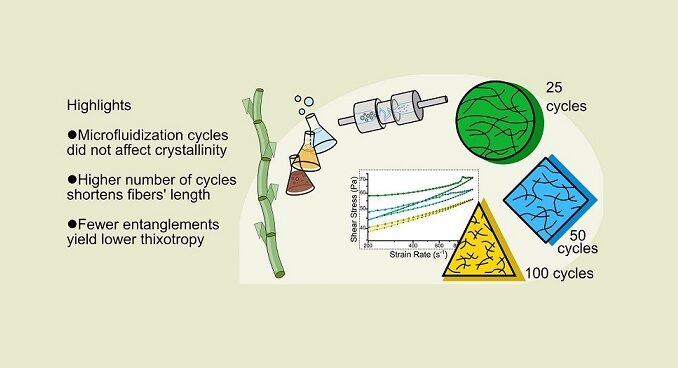
Oxidized cellulose nanofibers from sugarcane bagasse obtained by microfluidization: Morphology and rheological behavior
Abstract: It is advantageous to understand the relationship between cellulose fiber morphology and the rheological behavior of its dispersions so that their application can be optimized. The goal of this study was to produce sugarcane bagasse-sourced cellulose dispersions with different numbers of high-pressure homogenization cycles. Microfluidization produced cellulose nanofibers (between 5 and 80 nm in diameter) with similar surface charge densities and crystallinities (measured on the resulting films). Oscillatory rheology showed that TEMPO-oxidized cellulose dispersions exhibited gel-like behavior. However, not only did the samples with more microfluidization cycles present a lower storage modulus, but the sample with 100 cycles completely lost the gel-like characteristic, presenting a viscous fluid rheological behavior. Thixotropy loop tests revealed the influence of nanofiber length on the dispersion’s structure, as evidenced by the decrease in the hysteresis value along with fiber breakage. Therefore, our findings demonstrate that the rheological properties of the dispersion can be tuned according to the length of the nanofibers, allowing for targeted applications.
Author(s): Pessan, C. C.; Bernardes, J. S.; Bettini, S. H. P.; Leite, E. R.
Carbohydrate Polymers
Published: 15 March 2023, Volume 304, 120505
DOI: https://doi.org/10.1016/j.carbpol.2022.120505
CDMF
The CDMF, hosted at the Federal University of São Carlos (UFSCar), is one of the Research, Innovation and Dissemination Centers (RIDC) supported by the São Paulo State Research Support Foundation (Fapesp), and also receives investment from the National Council Scientific and Technological Development (CNPq), from the National Institute of Science and Technology of Materials in Nanotechnology (INCTMN).




